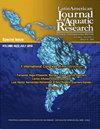A global-level assessment of gulls (Larus spp.) as bioindicators of trace elements in coastal ecosystems
IF 0.8
4区 农林科学
Q3 FISHERIES
Latin American Journal of Aquatic Research
Pub Date : 2023-04-30
DOI:10.3856/vol51-issue2-fulltext-2977
引用次数: 1
Abstract
Anthropogenic activities and the demand for trace elements have risen, causing an increase in their environmental levels, which could affect biota. High levels of trace elements in living beings have been associated with toxicity, metabolic disorders, oxidative stress, and cancer. Seabirds, such as gulls, have been used as bioindicators of environmental pollution caused by anthropogenic sources. Gulls are widely distributed worldwide, usually occupying high trophic levels, and living close to humans. Among gulls, Larus spp. are omnivorous, predominantly carnivorous, nest on the ground, and capture live food or steal it opportunistically. The present work summarizes the data of trace elements found in eggs, feathers, blood, and feces, among other internal tissues, of several gull species of the genus Larus around the world. Most of the reports are from the Northern Hemisphere (70%), particularly from Europe and North America. The elements Cd, Hg, Mn, Pb, and Se are the most studied (54%), among which Hg represents about 19%. On the other hand, there is no information for lesser-known trace elements such as Rb, Ti, new technology elements (e.g. Ge, Re, Ta), rare earth elements (e.g. Ce, La, Y), or elements of the platinum group (e.g. Os, Ir, Ru). Even though Larus spp. is a suitable bioindicator of chemical contamination in marine ecosystems, only 28 of the 53 species of the Larus genus have been used on trace elements pollution. Future research should address lesser-known elements which are increasingly used by new technologies.海鸥(Larus spp.)作为沿海生态系统微量元素生物指标的全球水平评估
人类活动和对微量元素的需求增加,导致其环境水平增加,这可能影响生物群。生物体内高水平的微量元素与毒性、代谢紊乱、氧化应激和癌症有关。海鸥等海鸟已被用作人为环境污染的生物指标。海鸥在世界范围内广泛分布,通常占据高营养水平,生活在人类附近。在海鸥中,Larus是杂食性的,主要是肉食性的,在地上筑巢,捕捉活的食物或伺机偷窃。本文总结了世界上几种海鸥属的蛋、羽毛、血液、粪便和其他内部组织中微量元素的检测数据。大多数报告来自北半球(70%),特别是来自欧洲和北美。Cd、Hg、Mn、Pb、Se是研究最多的元素(54%),其中Hg约占19%。另一方面,不太为人所知的微量元素,如Rb、Ti、新技术元素(如Ge、Re、Ta)、稀土元素(如Ce、La、Y)或铂族元素(如Os、Ir、Ru)的信息则没有。尽管Larus spp.是海洋生态系统化学污染的理想生物指标,但在53种Larus属植物中,仅有28种被用于监测微量元素污染。未来的研究应针对新技术日益使用的鲜为人知的因素。
本文章由计算机程序翻译,如有差异,请以英文原文为准。
求助全文
约1分钟内获得全文
求助全文
来源期刊

Latin American Journal of Aquatic Research
FISHERIES-MARINE & FRESHWATER BIOLOGY
CiteScore
1.70
自引率
10.00%
发文量
44
审稿时长
4-8 weeks
期刊介绍:
Latin American Journal of Aquatic Research- LAJAR is the continuation of the journal Investigaciones Marinas (1970-2007) and is published since 2008 by the Escuela de Ciencias del Mar, Facultad de Ciencias del Mar y Geografía of the Pontificia Universidad Católica de Valparaíso. LAJAR is an “Open Access” journal that publishes in English language, original research articles, reviews and short communications on aquatic science, which contain the results of research conducted in aquaculture or in oceanic and coastal marine waters of Latin America.
The following topics are considered: Physical Oceanography, Chemical Oceanography, Marine Biogeochemistry, Marine Pollution and Toxicology, Marine Geology and Geophysics, Biological Oceanography, Fisheries and Aquaculture.
 求助内容:
求助内容: 应助结果提醒方式:
应助结果提醒方式:


